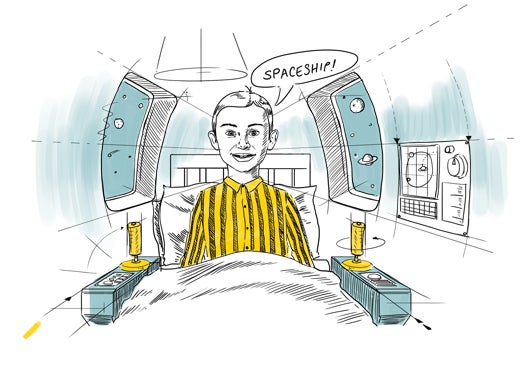FYI: Is It Possible To Control Our Dreams?
Yes, but only with practice. The best place to start is right before bed. Deirdre Barrett, a professor of psychology...


Spaceship!
Yes, but only with practice. The best place to start is right before bed. Deirdre Barrett, a professor of psychology at Harvard University and author of The Committee of Sleep, asked 76 college students to choose a problem (where to take a vacation; how to arrange their furniture) and focus on it while falling asleep. The subjects recorded their dreams for a week, and graduate students reviewed the material and found that a third of the students successfully solved the problem in their dreams. One student was trying to decide whether to go to graduate school in Massachusetts or California. He dreamed he was flying in a plane that was having engine trouble when he suggested that the pilot try to land in Massachusetts. The pilot said it was better to head toward the bright light in the West.
Imagery rehearsal therapy, or IRT, is a more active, daytime method of dream influence that psychologists use to help trauma victims prevent recurring nightmares. (Nightmares affect some three million people in the U.S. who suffer from post-traumatic stress.) Participants write out a happy version of the nightmare—in place of a fanged monster, a puppy; instead of a dark alley, a sunny street—and visualize it for 15 minutes a day. A group of patients in the VA San Diego Healthcare System who completed a course in IRT therapy experienced 33 percent fewer nightmares after five weeks.
During a lucid dream, it’s possible to act rather than simply react, explains Jane Gackenbach, a professor of psychology at Grant MacEwan University in Alberta and the author of Play Reality. About 58 percent of people have experienced a lucid dream at least once, she says. Gackenbach has investigated military videogames as a way to help soldiers cope with combat-related nightmares. “In their military dreams, soldiers who rarely played videogames couldn’t pull the trigger,” she says. “They were helpless in the face of danger.” But gamers could hide behind a boulder and shoot and fight back.
Dream control is inexact, though. As Robert Waggoner, the author of Lucid Dreaming: Gateway to the Inner Self, puts it: “The sailor does not control the sea, and neither does the lucid dreamer control the dream.” Gackenbach, too, has found that her subconscious has a way of fighting back: “I was sitting on a bench in Central Park, and I knew I was dreaming. A beautiful woman in a white hat was walking by. I decided to try to change her hat into a monster, but I couldn’t. Instead, she changed into a wolf and bit me.”
This article originally appeared in the January 2012 issue of _Popular Science magazine._